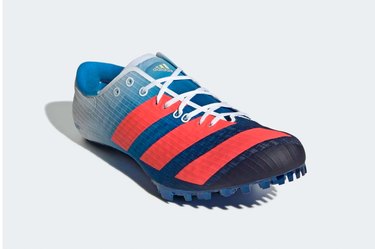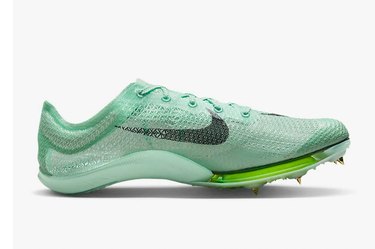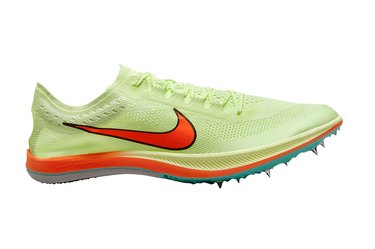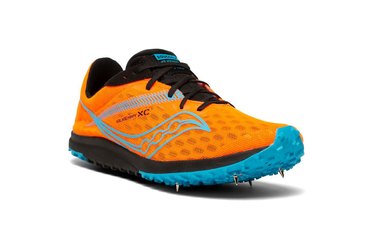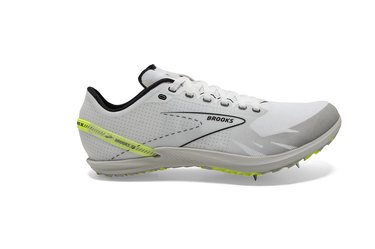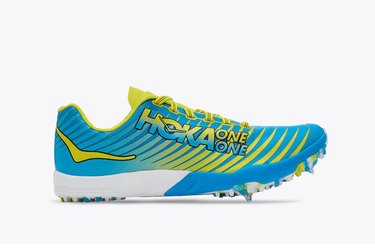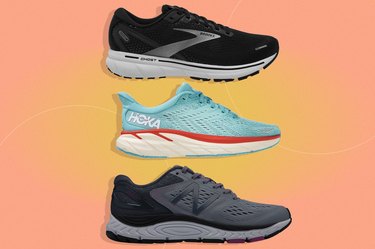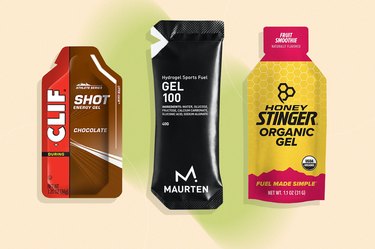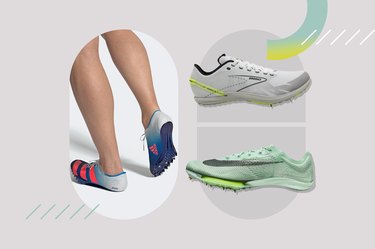
If running is your passion, dabbling in sports like track and cross-country is a no-brainer. But with each sport comes race-specific footwear known as spikes. Knowing what spikes are and how they differ between track and cross-country is key for a successful season.
Read on to learn the distinction between track spikes and cross-country spikes. Plus, find several great pairs to try.
Video of the Day
Video of the Day
What’s the Difference Between Track and Cross-Country Spikes?
In general, track spikes have minimal cushioning, but various models are designed differently based on the event (sprinting, jumping and distance), says ZZ Gore, CSCS, a performance coach with the Future personal training app and former track runner.
For example, sprint spike shoes typically have a plastic plate in the forefoot and little-to-no cushioning in the heel.
"This is due to sprinting taking place primarily on the ball of the foot," Gore tells LIVESTRONG.com. The plate acts like a spring and can help propel the foot a little faster compared to a standard running shoe, she adds.
Distance track spike shoes have slightly more cushioning and no plate in the forefoot to encourage a more natural foot strike.
Meanwhile, cross-country spikes have a bit more cushioning and material to support your feet over longer distances. Plus, they offer traction to help you navigate the uneven ground you'll find on cross-country courses, Gore says.
"Some cross-country spikes have mud- and grass-specific tread as well to help runners deal with the uneven and often torn up ground found on cross-country courses," says Owen Hoeft, an assistant cross-country and track coach at the University of Minnesota and running coach with North Coast Running.
How We Chose
We chatted with a running coach and past track runner to learn the ins and outs of track and cross-country spikes. Then, we gathered a few great track and cross-country spikes for you to check out. Every pair meets the following criteria:
- Price
- Quality
- Materials
- Comfort
Why Are Certain Shoes Marketed to Men or Women?
We make deliberate choices about the language we use, but most manufacturers typically market shoes according to gender, so we have listed both women's and men's picks below according to the language used by the brands.
However, there is very little difference between women’s and men’s spikes, according to Gore. Men’s shoes are typically wider, so if you have narrow feet, it’s best to stay away from men’s and unisex spikes, she says. We encourage everyone to shop according to their personal preferences rather than feel restricted by marketing lingo.
Best Track Spikes
1. Best for Sprinting: Adidas Adizero Finesse
These shoes were built for max speed. Per the manufacturer, the Adizero Finesse was fine-tuned for 200-meter and 400-meter events, but they can also work for the 100-meter events. They feature a molded forefoot plate to propel you along curves and straight-aways. A reinforced ripstop mesh upper offers a snug, locked-in fit.
The best part: These sprinting shoes were made in part with recycled materials. They come in a striking color with the Adidas stripes.
Buy it: Adidas.com; Price: $130
2. Best for Middle-Distance: Nike Air Zoom Victory
Hoeft recommends these Air Zoom Victory spikes for track events between 800 and 1,500 meters. These kicks contain lightweight cushioning in the heel for a responsive feel and optimal energy return with each step. The brand's AtomKnit fabric upper offers a breathable, contoured fit, which ensures the shoe will stick with you without weighing you down.
Score these spikes in mint green or blazing yellow.
Buy it: Nike.com; Price: $180
3. Best for Long-Distance: Nike ZoomX Dragonfly
For track events that are 1,500 meters and longer, Hoeft suggests these ZoomX Dragonfly spikes. They feature the brand's proprietary ZoomX foam for lightweight support and a spring-like feel. A lightweight mesh upper helps your feet breathe while locking them in place.
You may also be able to use these shoes for cross-country events. Just check that the metal spikes are the appropriate length. (More on this shortly.)
Get this spike in an eye-catching combo of yellow and orange.
Buy it: DicksSportingGoods.com; Price: $150
Best Cross-Country Spikes
1. Best for Beginners: Saucony Kilkenny XC9
These highly rated cross-country spikes are great for beginners and veterans alike. The Kilkenny XC9s have a four-pin plate on the sole to help you grip the terrain. They also offer a breathable mesh upper and a little cushioning in the sole to keep you comfortable for the duration of the race.
They're available in several color combinations.
Buy it: Saucony.com (men’s); Saucony.com (women’s); Price: $65
2. Best for All Terrains: Brooks Draft XC
Hoeft likes the Draft XC spike because it can handle the demands of any conditions you find yourself in along the race course. This shoe is studded with six metal spikes to give you extra traction. Plus, it has extra cushioning between your foot and the ground for maximum comfort.
This spike comes in a clean white with black and yellow accents.
Buy it: BrooksRunning.com; Price: $70
3. Most Cushioned: Hoka EVO XC
The EVO XC spikes are the priciest on our cross-country list, but they're definitely the softest. So, if you prefer cross-country spikes with a bit more cushioning, check these out.
However, they still offer features you'd expect in a performance shoe: a low-profile cushion bed to keep your feet close to the ground, a firm forefoot for better push-off and a raised rubber tread for greater traction.
Get these spikes in a bright cyan and citrus color combo.
What to Know Before Buying Track and Cross-Country Spikes
1. The Fit Varies
Track and cross-country spikes fit differently.
A track spike should be quite snug. "It's normal to get your spikes a half or full size smaller than your training shoes," Gore says.
For shorter events (100 to 400 meters), you want the shoe to fit like a sock. However, longer events (800 meters and longer) call for a bit more space, Gore says.
Cross-country spikes should have a little extra room — about half a thumbnail's distance between your big toe and the edge of the shoe is perfect. "This is because the race distance is longer, and therefore, your foot will swell a bit throughout the race," Gore says.
Find your perfect fit by visiting your local running store and trying a few pairs on.
2. Spikes Come in Different Lengths
As the name suggests, spikes have metal spikes in the bottom of the shoe. The shape and length of the spikes vary depending on the sport and race course.
"In cross-country, the standard length is a 1/4-inch in a pyramid shape," Gore says. These spikes are great for dry courses that have little-to-no pavement. But if the conditions are muddy, you might be able to swap them out for 3/8- or 1/2-inch spikes.
"Track spikes are more regulated due to the damage they can cause on the track," Gore says. The maximum length allowed is 9 millimeters in a pyramid shape, but some race officials will only allow 3 or 6 millimeters, she adds.
Metal spikes are interchangeable and can be bought individually. Gore recommends getting an extra set of metal spikes and changing them out at least every four races. "That will help your money go longer," she says.
3. They’re Often Event-Specific
Be sure to use cross-country spikes for cross-country events. "They can be used on the track as well, so long as you change the length of the metal spikes," Gore says.
However, sprinters will want to stick with track spikes designed for shorter events. Distance and cross-country spikes offer more cushioning than sprinters need.
Just don't wear a track-specific spike on a cross-country course. Track spikes force you to run up on your toes a bit more, because the events are typically much shorter. If you try to run a longer event like a cross-country race in a track spike, your performance will suffer and you may get injured, Hoeft says.
